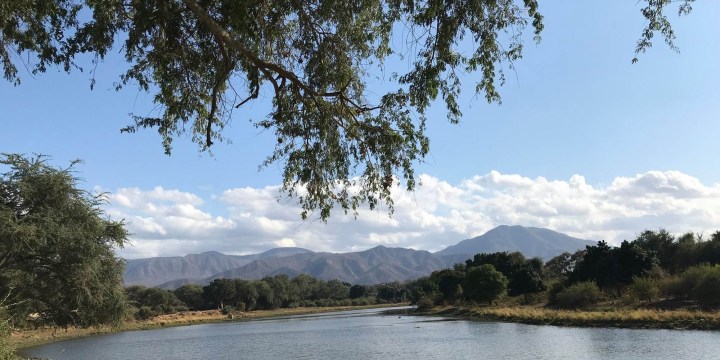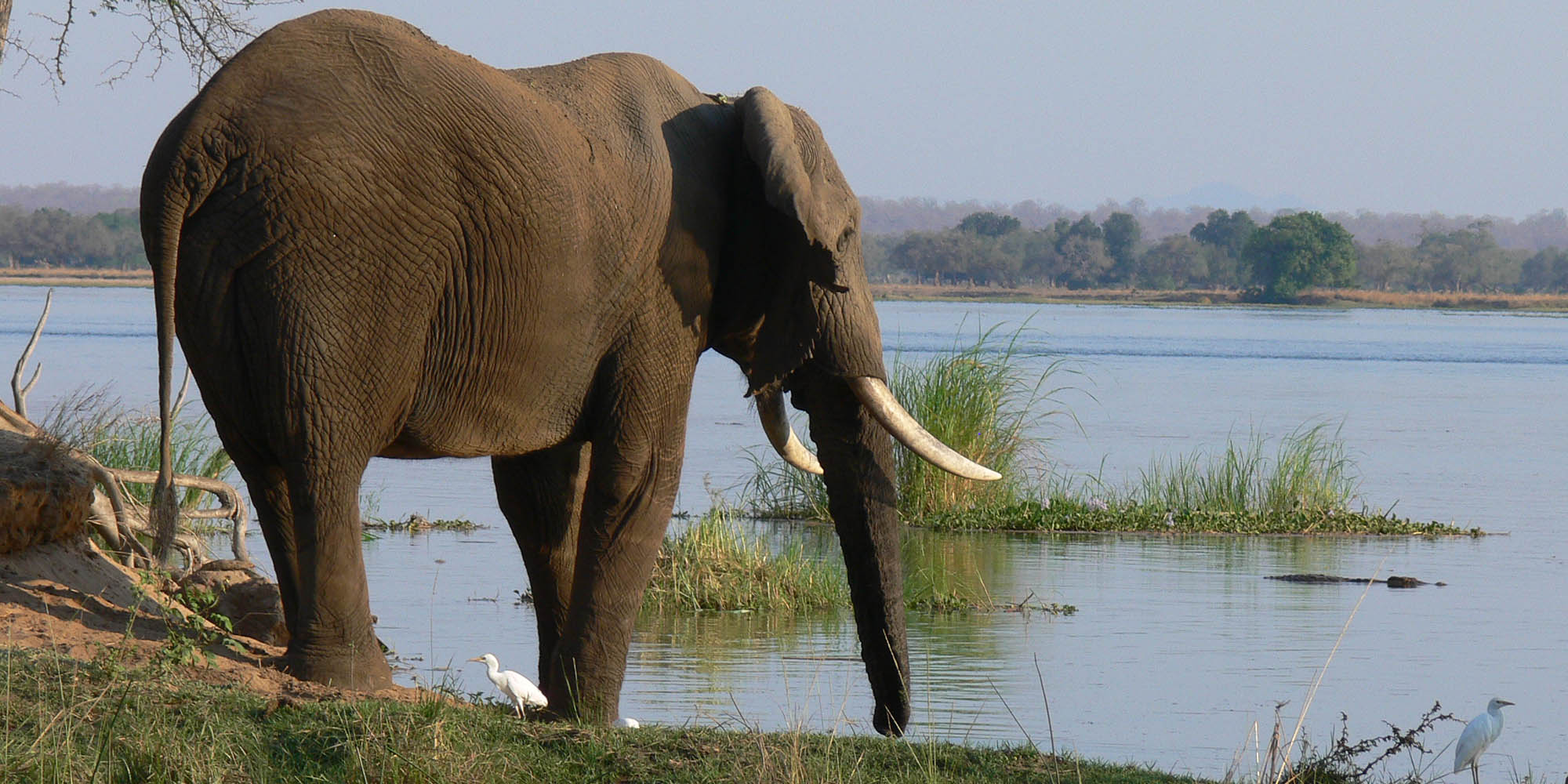Maverick Citizen: Zambia
Judgment day for controversial mining deal in the Lower Zambezi National Park

On October 14 a much-anticipated judgment of the Lusaka High Court will decide the fate of the Lower Zambezi National Park and, by default, many of the communities whose livelihoods depend on it.
A pod of hippos grunts at the mouth of the Chongwe River where it joins the Zambezi. The sun is just starting to rise and the entire Lower Zambezi valley is bathed in a soft, pre-dawn pink light. On the Zimbabwean side of the river sits Mana Pools National Park – a Unesco World Heritage Site. On the Zambian side, the twin peaks of Chilapila and the Zambezi Escarpment dominate the horizon.
Caught between Kariba Dam some 150km upstream and Cahora Bassa, less than 100 clicks downstream, the Zambezi is wide and lazy here. Dotted with islands, its wide floodplains are marked by a multitude of seasonal channels and tributaries on the Zambian side that flow down from the mountains above when the annual rains arrive, usually in November each year.

Wildlife in the Lower Zambezi National Park. (Photo: supplied)
Wedged between two of these tributaries — the Chakwenga and the Kangaluwi — around 19km inland from the river and some 800m above the valley floor sits a nondescript parcel of land that could effectively spell the end of this small slice of African paradise.

The site of the proposed Kangaluwi Copper Project. Image by Dr Kelly Leigh. (Photo: supplied)
This is the site of the proposed Kangaluwi Copper Project — an open-cast copper mine that if allowed to go ahead threatens the health of the Zambezi from this point downstream to its delta, more than 800km away on the Mozambican coast. The question of whether it will go ahead will be answered by the Lusaka High Court on 14 October, when judgement will finally be handed down in a legal battle that has lasted more than five years and on which the future of this otherwise pristine wilderness hinges.
Politics, politics…
It is incongruous that such a thing would be allowed in what is one of the region’s leading tourism hotspots, which is precisely what the Zambian people, a number of NGOs and various tourism and conservation stakeholders thought when they sought to oppose this outlandish scheme. They first raised their voices following the application in 2010 by Bermudan-registered Mwembeshi Resources Ltd for a large-scale mining licence in the park.

Map showing the mine site. (Image: Zambezi Resources)

Proposed mine layout. (Image: supplied)
At that time, although legally a Bermudan company, Mwembeshi Resources was selling itself as a Zambian “BEE” subsidiary of Zambezi Resources, an Australian-owned firm based in Perth, with local offices in Lusaka.
The environmental impact study in support of the mining application was full of holes and suspicion was rife that there was collusion and underhanded dealings in the corridors of power presided over by then President Rupiah Banda and his Movement for Multiparty Democracy (MDM)-led government.
Things changed in September 2011 when the Patriotic Front (PF) won the country’s general elections and a new President — Michael Sata — was sworn in. Sata had been victorious thanks, in part, to his commitment to combat corruption and government graft: a year later the Zambian Environmental Management Agency (ZEMA), the country’s independent environmental regulator and co-ordinating agency that advises government, announced that the Kangaluwi Copper Project EIS had been rejected outright.
In its summary, ZEMA said: “The proposed site is not suitable for the nature of the project because it is located in the middle of a national park, and this intends to compromise the ecological value of the park as well as the ecosystem.”
The Kangaluwi Copper Project was stopped in its tracks. Or so everyone thought…
Over the next couple of years, President Sata’s rule unravelled with allegations of serious corruption surfacing, tarnishing him, the PF and Zambia’s international reputation. These allegations seemed to have substance when, in January 2014, Harry Kalaba, the Minister of Land, Natural Resources and Environmental Protection, overturned ZEMA’s ruling and promptly issued Mwembeshi/Zambezi with its mining permit, claiming the mine would eventually “create employment for ordinary Zambians in the area”.
Local NGOs were quick to act and immediately joined forces to launch a court application for an urgent interdict to prevent the mine from going ahead. A stay of execution was granted pending the outcome of the application — an outcome that never came.
Fast forward, and rewind…
Through a series of long-winded legal processes, lapsed time frames and the apparent backing off of both government and Mwembeshi/Zambezi, the stay of execution is still in effect today. However, a ruling is expected next Monday, 14 October following a directive from the Zambian government that this case be wrapped up — more than five years after it began.
A lot has happened in the intervening years.
President Sata died in November 2014 and was replaced by Edgar Lungu, who narrowly won a general election in 2016 amid claims of electoral fraud. Since then the country has spiralled into a serious economic downturn with corruption apparently out of control.
In June this year, a fresh affidavit was lodged in Lusaka’s High Court by the respondents – Mwembeshi Resources Limited and the Zambian Attorney General – effectively reviving the case.
But this was no longer the Mwembeshi Resources that originally sought the licence. Zambezi Resources Ltd changed its name in January 2017 to Trek Metals Ltd and in April this year sold Mwembeshi and the Kangaluwi Copper Project to a Dubai-based investment company named Grand Resources Ltd.
According to Trek Managing Director Bradley Drabsch in a notice to the Australian Securities Exchange (ASX) on 15 April this year, Trek effectively trashed Mwembeshi while waiting for the written judgment from the Lusaka High Court on the validity of its mining licence. Grand Resources Ltd paid just AU$1,1-million for Mwembeshi and the Kangaluwi project and absorbed its considerable debts.
According to court papers lodged in June this year in Lusaka, Mwembeshi is represented by Marinko Vidovic, with a personal address listed in Perth, Western Australia. Vidovic is apparently Mwembeshi’s CEO, but quite why the affidavit lists his personal address and not the address of Mwembeshi’s offices in Perth is unclear. Mwembeshi is registered in Bermuda, and according to the island nation’s trade registry, Grand Resources’ contact address in Dubai is listed as “care of” Trident Trust Co.
Upon contact, Trident Trust refused categorically to divulge any details of Grand Resources Ltd but confirmed that it represented the firm but was not at liberty to speak to anyone save an “allocated point of contact”.
Various phone calls to both Mwembeshi’s Perth offices and Vidovic have gone unanswered. All that exists is supposition and suspicion and the cold spectre of China looming large.
The internet reveals there is a Grand Resources in China, based in Beijing, but attempts to contact it have ended in frustration (the writer does not speak Mandarin) and no apparent connections to Dubai have been discovered.
One way, or another…
There is considerable fear that irrespective of what transpires in the Lusaka High Court on 14 October, the result is a foregone conclusion and the Kangaluwi Copper Project will ultimately be (once more) rubber-stamped.
Which begs the biggest question this entire case throws up – why?
Why is there such a seemingly inexhaustible drive to push this mining project forward, given where it would be located and the mountains of opposition it faces and is likely to face in future? Mining experts have questioned its economic viability; conservationists, tourism operators, renowned scientists and the world’s most recognised environmental agencies have variously decried it and the Zambian people have taken to the streets in protest over it.
There’s obviously a huge hidden agenda at play.
Prospecting for this project began back in 2003. In those early days, both Mwembeshi and Zambezi Resources posted bullish internal reports and updates to the ASX. On 30 January 2008 Zambezi Resources informed the ASX of “encouraging results” for a “copper-gold project” at the Kangaluwi site, adjacent to the site of the Chakwenga Gold Mine that closed in 1943. Additional internal memos refer to finds of uranium.
Then there’s the biggest elephant in the room, China. Like most of its neighbouring countries and a large portion of the sub-continent, Zambia seems to have sold its soul and natural resources to China in exchange for “investment”. It is not unreasonable to expect that if it is not already owned by a Chinese company, any licence awarded to Mwembeshi would inevitably sell to a Chinese mining conglomerate ready to reap the riches covered in its subsequent agreement with the Zambian government.
This includes the exclusive rights to carry out mining operations and other acts reasonably incidental thereto in a 250 sq km area for a period of 25 years with all economic minerals in the area covered. The royalty on open-cast mining operations is 20% and the income tax is 30%. Which means the Zambian Government stands to benefit hugely from the Kangaluwi project, both above and below the table.
There is also an undoubted additional benefit for a Chinese mining company setting up shop inside a national park renowned for its elephant population. Copper, gold and ivory, a veritable trifecta of irresistible African resources.
Then, add a bit of uranium and you’ve probably hit Chinese pay dirt.
For the people, by the people…
The Lower Zambezi National Park is a national treasure where Zambians are concerned. The country’s third-biggest tourism draw-card after the Victoria Falls and South Luangwa National Park, it covers an area of just over 4,000 sq km including 120km of the riverbank. Surrounded by game management areas (GMAs) and community-owned buffer zones, the park is one of Zambia’s most lucrative and best managed, thanks to an active tourism community and prominent conservation NGO, Conservation Lower Zambezi (CLZ), both of which work extensively with government agencies and local communities.

Communities in the Chiawa GMA depend on tourism SGR. (Photo: supplied)
The people in the Chiawa GMA on the park’s western borders depend heavily on tourism and conservation, either directly through jobs or indirectly through being supported by those who have jobs. The Lower Zambezi Tourism Association represents the collection of camps and lodges that operate both in the GMA and inside the park itself and work alongside CLZ in helping to fund a variety of outreach and inreach programmes from anti-poaching patrols to environmental education and training.
There is no doubt the proposed mine will effectively kill tourism in the area, and spell the end of a thriving micro-economy that’s been built around it, putting hundreds of people out of work and plunging the thousands who depend on them into crisis.
From a conservation point of view, the mine would be a disaster, with tailings dams positioned just a few hundred metres above the valley floor posing a major threat to the health of Africa’s fourth-largest river system as it flows eastwards to the Indian Ocean.
It would be dangerous for Zambia to underestimate the impact greenlighting the Kangaluwi project would have on its tourism arrivals and the international outcry it would cause. The government has little grasp of the opportunity a vibrant, sustainable tourism economy represents. Zambia’s tourism successes are entirely due to an active and well-organised private sector, a sector that relies on the country’s pristine natural resources for its daily bread. Tourists do not visit copper mines.
More important in the build-up to the next general election in 2021, rural people do not vote for governments who rob them of their livelihoods. It’s the people of the Lower Zambezi Valley who stand to lose the most in this scenario and will look for someone to hold accountable. And to blame. DM



















 Become an Insider
Become an Insider